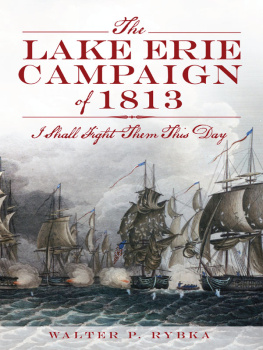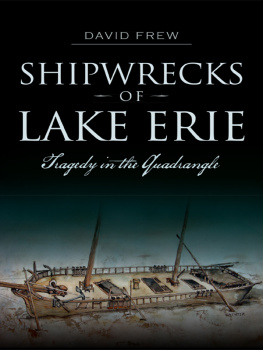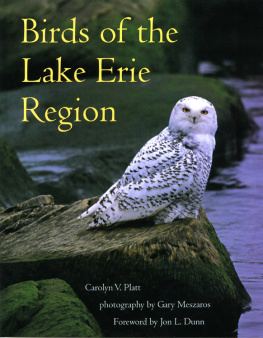Copyright Chad Fraser, 2008
All rights reserved. No part of this publication may be reproduced, stored in a retrieval system, or transmitted in any form or by any means, electronic, mechanical, photocopying, recording, or otherwise (except for brief passages for purposes of review) without the prior permission of Dundurn Press. Permission to photocopy should be requested from Access Copyright.
Editor: Tony Hawke
Copy-editor: Shannon Whibbs
Design: Jennifer Scott
Printer: Webcom
Library and Archives Canada Cataloguing in Publication
Fraser, Chad
Lake Erie stories : struggle and survival on a freshwater ocean / Chad Fraser.
ISBN 978-1-55002-782-2
1. Erie, Lake--History. 2. Erie, Lake, Region--History.
I. Title.
F555.F73 2008 971.33 C2008-900389-6
1 2 3 4 5 12 11 10 09 08
We acknowledge the support of the Canada Council for the Arts and the Ontario Arts Council for our publishing program. We also acknowledge the financial support of the Government of Canada through the Book Publishing Industry Development Program and The Association for the Export of Canadian Books, and the Government of Ontario through the Ontario Book Publishers Tax Credit program, and the Ontario Media Development Corporation.
Care has been taken to trace the ownership of copyright material used in this book. The author and the publisher welcome any information enabling them to rectify any references or credits in subsequent editions.
J. Kirk Howard, President
Printed and bound in Canada.
Printed on recycled paper.
www.dundurn.com
Dundurn Press
3 Church Street, Suite 500
Toronto, Ontario, Canada
M5E 1M2
Gazelle Book Services Limited
White Cross Mills
High Town, Lancaster, England
LA1 4XS
Dundurn Press
2250 Military Road
Tonawanda, NY
U.S.A. 14150
For Amy, who always keeps my bow turned into the wind.
Introduction
Lake Erie is not a peaceful inland sea. Even a seaman who has seen the worst that the worlds oceans could throw at a ship quickly learns to respect her unpredictable waters.
Captain Alexander McNeilledge, who created the first sailing chart of the north shore of Lake Erie in 1848, had this bit of advice for the captains who sailed the lake in his day:
When you are anxious to have a good lookout kept, you must keep it yourself [authors emphasis]. Running for the land, or being anxious to make a light in stormy, hazy, or thick weather, let your officers be never so good, be at the head of it yourself, and of course you will pay more attention, having it on your mind and being the responsible man.
McNeilledges book and chart are a revealing look at the life of a sailor on Lake Erie in the early days of settlement. It was a time when small communities, including Port Dover, where the old captain ended up settling down, were just beginning to emerge from untracked wilderness. The end of the War of 1812 the last great conflict between Canada and the emerging industrial powerhouse to its south had brought a lasting peace to the region, and cleared the way for the towns and cities that today line the shore to take root.
Photo courtesy of Port Dover Harbour Museum
Captain Alexander McNeilledge, author of the first sailing charts of Lake Eries north shore, was well known in Port Dover.
McNeilledge, who was born in Greenock, Scotland, in 1791, had spent much of his career on the ocean. His exploits are the stuff of seafaring legend: he first went to sea as a cabin boy at the age of eight, was shipwrecked on Long Island in 1807, saw the Duke of Wellington in Lisbon, and even caught a glimpse of Napoleon Bonaparte, the deposed emperor of France, in exile on the island of St. Helena in 1817. Even what he might have considered to be the more humdrum aspects of his time at sea are thrilling by modern standards. The captain covered huge swaths of the globe, sailing to ports as far afield as China, and running a naval blockade off Buenos Aires. And, for good measure, he endured robbery and plunder at the hands of pirates on the storied Spanish Main.
It is not hard to imagine, then, why McNeilledge was drawn to the quiet Canadian hinterland after such a frenetic career at sea. He first came to Port Dover in 1832, largely at the request of his brother, who had rebuilt an old mill in the town where, he hoped, Alexander could help him by serving as clerk and bookkeeper. Some time later, McNeilledge decided to expand his repertoire by dabbling in farming, as well.
But the life of a landlubber, predictably, could not hold the attention of the old captain for very long, and soon enough he heard the call of the freshwater ocean that now lay in his backyard. And, try as he might, McNeilledge couldnt resist. Soon he was back out on the water, sailing along both the north and south shores of Lake Erie on numerous ships and making a name for himself among the lakes growing fraternity of captains. Back on dry land, McNeilledge was a colourful figure in tiny Port Dover, where he produced a number of mementos, including drawings of ships, ports, and other images of marine life. During his spare time, he could usually be found down at the harbour, overseeing the comings and goings of the many sailing vessels and sharing tall tales of the sea with his fellow captains.
Still, even though he had experienced much during his long saltwater career, McNeilledge knew not to underestimate Lake Erie. Even in these early days of settlement, its temperamental nature was well known to those who sailed the lake or lived along its shores. The very existence of his chart and narrative about the many hazards of sailing the waters off the north shore speaks to the fact that the old captain spent a good deal of time worrying about his fellow sailors out on the lake. And he had good reason. Since the Welland Canal had opened in 1829, more and more ships were clogging Lake Erie, their holds stuffed with the food, stone, and lumber that were desperately needed to fuel the construction boom. Not surprisingly, the increased traffic brought with it more and more shipwrecks and a higher toll in human lives. Of his chart, McNeilledge says simply: The courses and distances will be found to be pretty correct for any stranger to go by, and will often ease the mind of the man having the charge.
The Shallow Sea
Lake Erie is the second smallest of the five Great Lakes by surface area (only Lake Ontario is smaller), and the smallest by volume. Its southerly location gives it a climate that is downright tropical in the summertime, prompting tourists from around the world to flock to places like Point Pelee, Long Point, and the Lake Erie islands, to bask in Eries warm waters and soak up the sun on some of the finest beaches in North America. Not as well recognized is the fact that Lake Erie is along the same latitude as northern California and Rome, giving the fertile farmland surrounding it a long and relatively moderate growing season. The rich soil produces bountiful harvests of a staggering variety of fruits and vegetables, not the least of which is grapes, the key to the regions growing winemaking industry.








